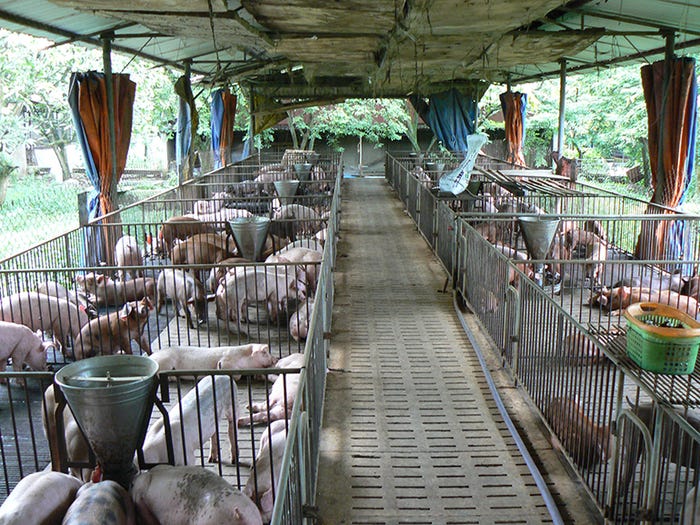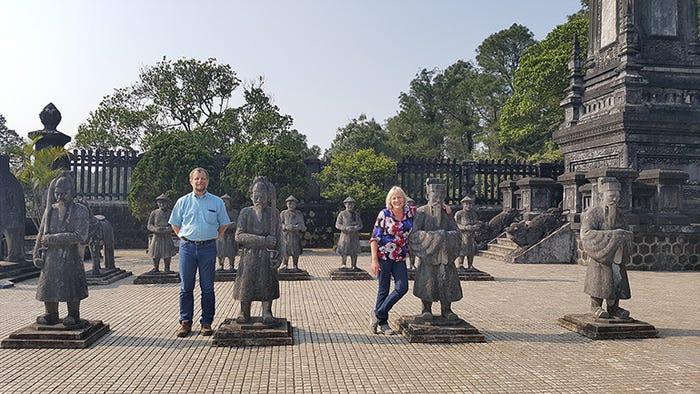What I saw in the Vietnamese swine industry reminded me of the structure of the U.S. swine industry in the late-1980s and early 1990s.
December 6, 2018

By Bob Thaler, South Dakota State University professor and Extension swine specialist
It soon became apparent that there were a lot more differences than just the weather between my home of Brookings, S.D., and Vietnam, where my wife and I would spend five months earlier this year on a Fulbright scholarship working at the Vietnam National University of Agriculture.
It was 30 below zero when we left Brookings on Jan. 2, and 28 hours later it was 67 when we landed in Hanoi, Vietnam.
The weather was the first of many differences that we would encounter, but there were also many more similarities than what we had anticipated.
Vietnam is a beautiful, dynamic and growing country, and it is slightly larger in size than New Mexico. It’s 97 million people are warm, engaging and are very welcoming.
They are a relatively young population with only 15.25% of their population older than 55 years of age as compared to 28.97% in the United States. The Vietnamese economy is strong with an average Gross Domestic Product growth rate of 6.6% over the last three years. Like elsewhere in the world, a young population with increased wealth has resulted in an increased demand for food, especially protein, in Vietnam. According to the USDA, Vietnam is No. 11 among U.S. ag export markets in 2017 ($2.5 billion), and has grown 414% in the last 10 years.
It’s hard to condense five months of experiences into one column, so I am just going to focus on a few main topics that I found pretty interesting.

1. Vietnamese pork production is going through a dramatic transition. Historically backyard production/small farms accounted for most of Vietnam’s pork production, and what I saw reminded me of the structure of the U.S. swine industry in the late-1980s and early 1990s. There are a lot of 50- to 200-sow farms, and many of them are farrow-to-finish on one site with continuous flow production. As we learned in the United States, it’s hard to break the disease cycle with those conditions, and disease pressure is one of the main factors limiting their productivity.
In 2014, they had 3.7 million sows producing 43.43 million pigs per year. From 2014 to 2016, Vietnam exported a large number of pigs to China, which resulted in some very high profit margins, and they did what most other producers do in good markets, they expanded their sow herd. Unfortunately, in 2016 China drastically reduced pig imports from Vietnam so live pig prices crashed in Vietnam due to the over-supply, and in 2018 many of the smaller and mid-sized producers were exiting the industry. Interestingly, there is still growth in large operations, both from Vietnamese producers and many companies from China and Thailand.
2. While Vietnam is one of the world’s top rice producers and exporters, they raise very little corn and soybeans. Therefore, they have to import almost all of the feed ingredients for their growing livestock, poultry and aquaculture sectors, and they are major importers of U.S. soybean meal, corn and distillers dried grains with solubles. However, that also means their feed costs are at least double what we have in the United States, so that is challenging. They do have significant cost advantages in labor and building costs, though, especially in the south where many swine barns don’t have walls. Their sow and pig productivity are substantially less than ours, but they are trying to move in the right direction.

3. I think what surprised me the most is just how much the Vietnamese people like Americans, which is hard for someone born in 1960 to grasp. However, they won the war, they’ve moved on, and I believe they see the United States as the best partner to help them achieve a better life for themselves and their families.
Everyone wants to learn English, and that has become a priority in Vietnam. In fact, once in Vietnam, my Fulbright changed from 100% teaching-research with swine to 50% teaching English/developing English curriculum/teaching their teachers to teach English and 50% pig stuff. Luckily, Karen the English teacher was able to handle that part, and she continually got requests from people to help them learn English.
When I’d ride my 150 cc Honda Dream II motorcycle in the country, people would shout “Hello” and want to shake my hand. I think one event that epitomizes the new relationship between Vietnam and the United States is when our aircraft carrier, the USS Carl Vinson, docked at Da Nang (the real China Beach) this March at the request of the Vietnamese government, and 3,800 U.S. sailors came ashore. They were great ambassadors, and we were very proud of them.
4. I spent time working with their Ministry of Agriculture and Rural Development on environmental regulations and antibiotic use in feed. While Vietnam’s livestock operations are growing in size, the average crop farm total size is still less than 2 acres, which means most fields are 1 acre or less. The problem is then how do you get the manure from a 600-sow farm to a 1-acre field that has been farmed for 2,000 years and desperately needs those crop nutrients.
Unfortunately, in the past some farms just let the manure go anywhere, resulting in polluted streams and ground water. To address that, the government is working on establishing environmental standards, but they are similar to what we have in the United States for municipalities, which is very difficult for livestock producers to achieve.
The responsible use of antibiotics in feed is another major issue they are dealing with. One of the options the government was considering is the total ban of antibiotics in the feed. Considering their disease pressure, that could cause a lot of issues, so we spent time going through the veterinary feed directive and how it would accomplish the same things without causing health and welfare issues to livestock.
5. We all need to thank the men and women who served in Vietnam. It was a terrible war on all sides, but most of our people went there with the best intentions in mind.
Unfortunately, many of our veterans are still affected by it every day. I’ve visited with veterans since coming back to South Dakota, and many of them still choke up and get teary-eyed talking about it 46 years later. If any of you reading this did serve in Vietnam, I can’t encourage you strongly enough to go back and visit Vietnam, as hard as you think that would be. It has been a very healing experience for most who have gone back, and hopefully it will be for you, too.
We had a great experience in Vietnam, and I believe they will grow into one of our best partners in Southeast Asia and the world. They want to work with us, and there are a lot of ways we can help each other, especially in agriculture.
You May Also Like



